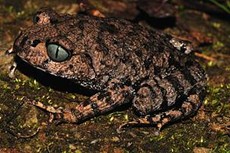Hundreds of new species discovered in the fragile Eastern Himalayan region
08 Oct 2015
A biological treasure trove of over 200 new species was discovered in the Eastern Himalayas between 2009 and 2014, according to WWF Living Himalayas Initiative's latest regional species discovery report.The report, released in Bhutan on 5 October on World Habitat Day, is entitled Hidden Himalayas: Asia's Wonderland, and maps out scores of new species found by scientists from various organizations across a region spanning Bhutan, north-east India, Nepal, the far north of Myanmar and the southern parts of Tibet.
 This year's report goes beyond celebrating the discovery of new and unique species: the report underscores the dire threats facing the vibrant ecosystems, including the sobering statistic that as a consequence of development, only 25 per cent of the original habitats in the region remain intact and hundreds of species that live in the Eastern Himalayas are considered globally threatened.
This year's report goes beyond celebrating the discovery of new and unique species: the report underscores the dire threats facing the vibrant ecosystems, including the sobering statistic that as a consequence of development, only 25 per cent of the original habitats in the region remain intact and hundreds of species that live in the Eastern Himalayas are considered globally threatened.
The volume and diversity of discoveries highlight that the region is one of the most biologically diverse places on the Earth, the discoveries listed equating to an average of 34 new species being found every year for the past six years.
The 211 discoveries include 133 plants, 39 invertebrates, 26 fish, 10 amphibians, one reptile, one bird and one mammal. Some of the most striking discoveries include a vibrant blue dwarf 'walking' snakehead fish (Channaandrao) which can breathe atmospheric air and survive on land for up to four days although, moving in a manner much clumsier than a smoothly slithering snake. The report details an unfortunate monkey (Rhinopithecusstrykeri) whose upturned nose leads to a sneeze every time the rain falls, and a living gem - the bejeweled lance-headed pit viper (Protobothropshimalayansus) -which could pass as a carefully crafted piece of jewellery.
''I am excited that the region – home to a staggering number of species including some of the most charismatic fauna – continues to surprise the world with the nature and pace of species discovery,'' said Mr. Ravi Singh, CEO and Secretary General of WWF-India and Chair of the WWF Living Himalayas Initiative.
 The region is currently facing a wide range of threats and pressures, with climate change assessed as by far the most serious. Population growth, deforestation, overgrazing, poaching, the wildlife trade, mining, pollution and hydropower development have all contributed to the pressures on the fragile ecosystems in the region, the report says.
The region is currently facing a wide range of threats and pressures, with climate change assessed as by far the most serious. Population growth, deforestation, overgrazing, poaching, the wildlife trade, mining, pollution and hydropower development have all contributed to the pressures on the fragile ecosystems in the region, the report says.
''The challenge is to preserve our threatened ecosystems before these species, and others yet unknown, are lost,''said leader of the WWF Living Himalayas Initiative, Sami Tornikoski.
The Eastern Himalayas is at a crossroads. Governments can decide whether to follow the current path towards fragile economies that do not fully account for environmental impacts, or take an alternative path towards greener, more sustainable economic development.
The stakes are high: the Himalayas harbour at least 10,000 plant species, 300 mammal species, 977 bird species, 176 reptiles, 105 amphibians and 269 types of freshwater fish. In addition to this, between 1998 and 2008 in the Eastern Himalayas, at least 354 new species were described as new to science.
 In a bid to protect the region's rich diversity of flora and fauna, WWF is actively involved in supporting the countries of the Eastern Himalayas' progress towards green economies that value ecosystems and the services they provide to the millions of people in the region. Being located in perhaps one of the most ecologically fragile regions on the Earth, the WWF Living Himalayas Initiative urges a strong regional collaboration to ensure that people in this region - where ecological interconnectedness take heightened reality - live within the ecological means and remain within the boundaries of one planet.
In a bid to protect the region's rich diversity of flora and fauna, WWF is actively involved in supporting the countries of the Eastern Himalayas' progress towards green economies that value ecosystems and the services they provide to the millions of people in the region. Being located in perhaps one of the most ecologically fragile regions on the Earth, the WWF Living Himalayas Initiative urges a strong regional collaboration to ensure that people in this region - where ecological interconnectedness take heightened reality - live within the ecological means and remain within the boundaries of one planet.
Through approaches such as sustainable hydropower development, valuation of natural capital, landscape and species conservation, climate change adaptation, and sustainable financing mechanisms, WWF will continue to develop and support programmes in the region that help secure a brighter future for the region's people and biodiversity, including its rich array of species – those that we already know and those still waiting to be discovered.
(See: report: Walking fish, sneezing monkey among 211 new Himalayan species)













.jpg)






.jpg)









